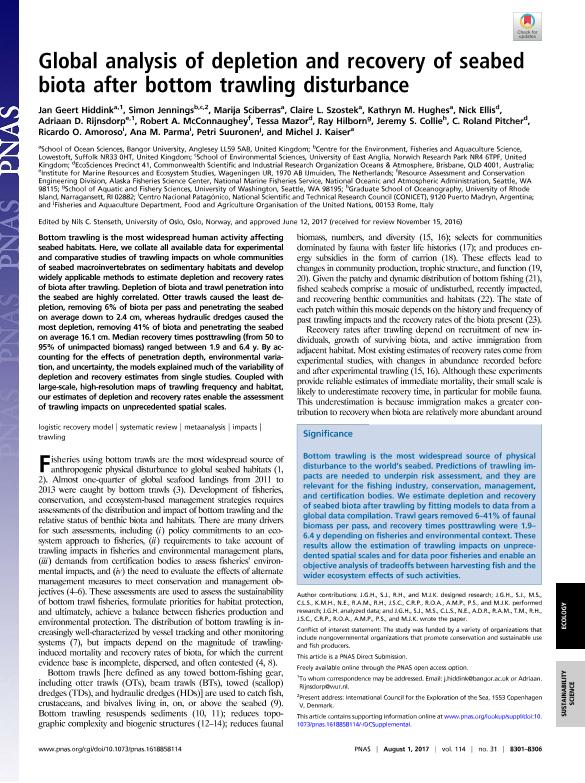Artículo
Global analysis of depletion and recovery of seabed biota after bottom trawling disturbance
Hiddink, Jan Geert; Jennings, Simon; Sciberras, Marija; Szostek, Claire L.; Hughes, Kathryn M.; Ellis, Nick; Rijnsdorp, Adriaan D.; McConnaughey, Robert A.; Mazor, Tessa; Hilborn, Ray; Collie, Jeremy S.; Pitcher, C. Roland; Amoroso, Ricardo Oscar ; Parma, Ana María
; Parma, Ana María ; Suuronen, Petri; Kaiser, Michel J.
; Suuronen, Petri; Kaiser, Michel J.
 ; Parma, Ana María
; Parma, Ana María ; Suuronen, Petri; Kaiser, Michel J.
; Suuronen, Petri; Kaiser, Michel J.
Fecha de publicación:
08/2017
Editorial:
National Academy of Sciences
Revista:
Proceedings of the National Academy of Sciences of The United States of America
ISSN:
0027-8424
e-ISSN:
1091-6490
Idioma:
Inglés
Tipo de recurso:
Artículo publicado
Clasificación temática:
Resumen
Bottom trawling is the most widespread human activity affecting seabed habitats. Here, we collate all available data for experimental and comparative studies of trawling impacts on whole communities of seabed macroinvertebrates on sedimentary habitats and develop widely applicable methods to estimate depletion and recovery rates of biota after trawling. Depletion of biota and trawl penetration into the seabed are highly correlated. Otter trawls caused the least depletion, removing 6% of biota per pass and penetrating the seabed on average down to 2.4 cm, whereas hydraulic dredges caused the most depletion, removing 41% of biota and penetrating the seabed on average 16.1 cm. Median recovery times posttrawling (from 50 to 95% of unimpacted biomass) ranged between 1.9 and 6.4 y. By accounting for the effects of penetration depth, environmental variation, and uncertainty, the models explained much of the variability of depletion and recovery estimates from single studies. Coupled with large-scale, high-resolution maps of trawling frequency and habitat, our estimates of depletion and recovery rates enable the assessment of trawling impacts on unprecedented spatial scales.
Palabras clave:
Impacts
,
Logistic Recovery Model
,
Metaanalysis
,
Systematic Review
,
Trawling
Archivos asociados
Licencia
Identificadores
Colecciones
Articulos(CESIMAR)
Articulos de CENTRO PARA EL ESTUDIO DE SISTEMAS MARINOS
Articulos de CENTRO PARA EL ESTUDIO DE SISTEMAS MARINOS
Citación
Hiddink, Jan Geert; Jennings, Simon; Sciberras, Marija; Szostek, Claire L.; Hughes, Kathryn M.; et al.; Global analysis of depletion and recovery of seabed biota after bottom trawling disturbance; National Academy of Sciences; Proceedings of the National Academy of Sciences of The United States of America; 114; 31; 8-2017; 8301-8306
Compartir
Altmétricas



